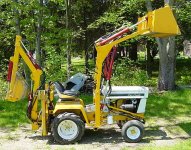uhmgawa
Gold Member
</font><font color="blue" class="small">( What about supporting the pieces your are welding? Can you hold one and not get shocked? As long as you dont get too hot through the glove> bw )</font>
The open circuit voltage for common stick and mig welders can
be as high as 70V or so. When you are drawing an arc that drops
down to 30-40V. So you might get a tingle if you tried.
But the greater concern is making sure the shower of
molten metal and UV is deflected from you. 'Deflected'
is rather important as you don't want to be garbed in
anything which can hold flying hot metal such as upward-
open shirt pockets or cuffs of any sort.
The open circuit voltage for common stick and mig welders can
be as high as 70V or so. When you are drawing an arc that drops
down to 30-40V. So you might get a tingle if you tried.
But the greater concern is making sure the shower of
molten metal and UV is deflected from you. 'Deflected'
is rather important as you don't want to be garbed in
anything which can hold flying hot metal such as upward-
open shirt pockets or cuffs of any sort.
